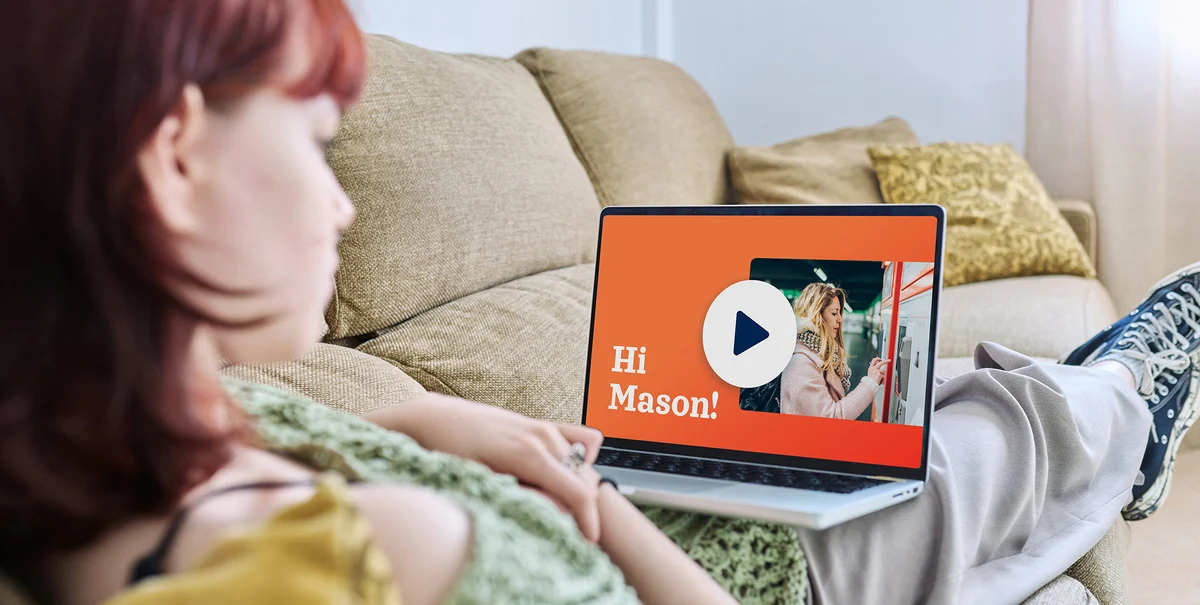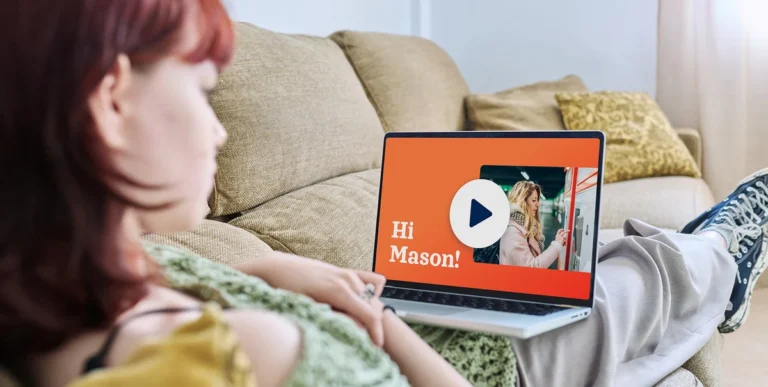Your inbox dings. “Happy birthday,” your dentist says. But before you can even react, here’s another alert. Chewy’s got a treat for Bark Ruffalo, your goldendoodle.
Another day, another marketing strategy. It’s one more email with your name slapped in the greeting, and it’s fast losing its shine. It’s no surprise to see your name (or your dog’s) in an email anymore. It’s not personalised enough to take up real estate in our brains. Enter companies using hyper-personalisation strategy to engage customers. The goal of hyper-personalisation is for your customers to feel that your brand knows them just like a person would know them.
First, let’s define this buzzword — hyper-personalisation. Then, we’ll check out 7 stellar examples of hyper-personalisation used by bold companies open to experimenting with it.
What is Hyper-Personalisation?
Post on
Consider hyper-personalisation your favorite barista. They’ve memorised your name (and its correct spelling). They also know your exact coffee order, down to the temperature and the extra dash of cinnamon.
The most important thing to remember about hyper-personalisation is that it is rich, 1:1 personalisation. As digital marketing jargon goes, hyper-personalisation is an approach that can leverage lots of tools and technologies — your CRM, real-time data, advanced analytics and more — to tailor products, services and experiences to each customer’s specific cravings.
Hyper-personalisation can deliver razor-sharp, personalised messages at lightning speed in a way that makes each interaction as relevant as your morning coffee. Artificial intelligence (AI), like Idomoo’s Enterprise AI Video, helps you create this hyper-personalised content at scale. And because of this, you’ll have customer interactions that strengthen relationships for long-term loyalty.
What Isn’t Hyper-Personalisation?
Let’s clear up a common mix-up. Customer segmentation and hyper-personalisation aren’t the same thing. It might help to think of it this way:
- Segmentation is a group photo. It lumps customers by shared traits and demographics.
- Hyper-personalisation is a selfie. It uses niche customer data to adapt key digital interactions to a unique, Netflix-like “just-for-you” experience.
The Role of Predictive Analytics and Machine Learning
You likely hear about predictive analytics and machine learning (ML) when learning about hyper-personalisation. Here’s the breakdown of each term:
- Predictive analytics: Uses what people liked before to guess what they want next
- Machine Learning: Algorithms adapt and personalise content based on user behavior
Keep in mind that hyper-personalisation is about making the individual feel seen and understood, and that doesn’t always require the latest gadgetry. They can be part of hyper-personalisation, but they’re not essential.
Instead of jumping headfirst into that, start by using the horde of untapped data sitting in your CRM (or other data sources). You can use that first-party data you have access to, or your users can interact with your content to personalise it themselves with their info and actions. That kind of hyper-personalisation is very effective.
All in all, hyper-personalisation is anything personalised with rich detail at the individual level. Think more than just a first name. Often our campaigns will have more than 20 personal data points! That’s hyper-personalised.
What Are the Benefits of Hyper-Personalisation?
According to McKinsey & Company, 71% of consumers expect personalised interactions. While 76% are frustrated when they don’t get the level of personalisation they expect. Here’s what customers love about hyper-personalised content:
- It’s easier to understand.
- They feel valued as an individual.
- Relevant information saves them time.
- They can discover interesting new things.
And 80% of business leaders report personalisation boosts customer spending with an average uptick of 38%. It’s no wonder companies love hyper-personalisation too.
So what is it about hyper-personalisation that makes this possible? Here are a few things that help.
- Customer engagement: Customised content enhances connection with your brand.
- Increased conversion rates: Targeted content prompts customers to act.
- Better customer experience: Understanding customer preferences leads to happier customers.
- Data-driven insights: Using customer data results in efficient and targeted marketing efforts.
- Stand out: Customised content helps your brand differentiate itself in a crowded market.
For example, Idoomoo found that Personalised Videos increase feelings of trust, loyalty and brand love 3x–4x more than non-personalised videos. Hyper-personalisation done well means understanding and analysing your target customer data points. It also means committing to creating a memorable and truly personal digital CX.
7 Brands Mastering the Art of Hyper-Personalisation
We could wax poetic about the usual suspects like Starbucks, Stitch Fix, Netflix and Spotify. But instead, let’s put a few other companies that are acing hyper-personalisation under the microscope.
1. Mr. Cooper Wins Customer Loyalty With Hyper-Personalised Videos
First up? Mr. Cooper — a mortgage lender known for its digital process, user-friendly app and diverse mortgage options. In this loyalty video, Mr. Cooper helps customers by showing them how they can free up money to support other financial goals they may have.
Imagine opening an email from Mr. Cooper featuring a video message personalised for you. It might include:
- Your name
- Street address
- Home value
- Remaining mortgage balance
- Estimated equity
The video then explains that refinancing your home frees up cash. And you could use the money to pay off debt, make home upgrades, or boost your emergency funds (all things you want to do anyway).
Mr. Cooper’s videos, created with Idomoo’s Next Generation Video Platform and tailored with individual customer data, show customers that Mr. Cooper cares about their financial well-being.
The hyper-personalisation takeaway? Our 2024 State of Video Technology report found that over 80% of folks want to see more brand videos. So using our video platform to create Personalised Videos for your email marketing will not only help with that personal touch, but it will also deliver on consumers’ constant demand for video content. It’s hyper-personalisation on a level that increases customer loyalty and customer retention.
2. Cleo Uses AI-Powered Hyper-Personalisation for Gen Z Finances
Next, Cleo is an AI-powered app that acts as your personal finance assistant, and its mobile app is packed with hyper-personalisation.
The app targets Gen Z (and younger millennials) with relatable memes, imagery and slang. While the user experience makes managing finances fun, it also meets a serious need. It analyses bills, income, purchase history, and spending habits to offer helpful tips and notifications.
The video below gives a good overview.
The standout feature is Cleo’s chat. Here, the subscriber can ask Cleo to use behavioral data for insights on expenses. They can also opt for a “hype” or “roast” — positive or negative feedback on their spending. It’s like a candid chat with a finance expert who doesn’t mince words about your spending habits.
The hyper-personalisation takeaway? Cleo’s success with Gen Z lies in AI-driven hyper-personalisation via its mobile app. It’s about using tech to deliver real-time, personalised advice based on user habits.
3. Carvana Drives Engagement With AI-Powered Personalised Videos
Carvana, an online used car buying and selling platform, puts a fun spin on the car-buying process. It might be best known for its car vending machines (towering glass structures where customers can pick up their new rides).
In May 2023, they launched “Joyride.” This project created over 1.3 million unique AI-generated videos to celebrate customers’ car purchases.
These videos used advanced AI tools like 3D car modeling, animation, AI-generated art and voiceovers. Then, Carvana personalised each video by including the following:
- Customer name
- Make and model of the car they bought
- When and where they bought it
- Relevant current events at the time of buying
Their system churned out up to 300,000 videos per hour, resulting in over 45,000 hours of content to date. For those who already feel a bond with their autos, this feels like looking through a family photo album. Those warm feelings help build an affinity for the Carvana brand.
The hyper-personalisation takeaway? Companies can create unique marketing content for each customer, even at scale, by using a mix of AI tools. Like Carvana, you can boost customer satisfaction and engagement with AI-driven videos to deliver personalised experiences that mirror the customer’s unique journey.
4. Orangetheory Increases Attendance With a Heartfelt Video
Gathering your gear and going to the gym every day can feel like a slog, and it can be a challenge to maintain the habit. That’s why Orangetheory Fitness created this hyper-personalised video to encourage members to show up at its boutique fitness studios and keep at it.
During workouts, members wear heart rate monitors to track and display real-time heart metrics. Orangetheory’s workouts are dynamically based on these metrics. So it’s only fitting that the video’s music in the video is, too.
Orangetheory’s Personalised Video created with our enterprise-grade platform celebrates each member’s progress. With music created around the individual’s heartbeat, the video shares their progress and highlights from the year’s workouts:
- Number of classes completed
- Challenges completed
- Splat points earned
- Calories burned
Including these details gave the videos that 1:1 human touch. And the video resonated with members. They shared them on social media, and during the campaign’s launch week, 45,000 classes were booked. Classes hit 97% attendance, and the following month saw the lowest churn rate in Orangetheory’s history.
The hyper-personalisation takeaway? The Orangetheory Fitness campaign proves creative hyper-personalisation gets results. When Orangetheory members heard their heartbeat as the video started, they felt recognised. It was something personal to them — a real part of them.
Each individual knows they’ve been working hard toward their goal, but it’s nice to be recognised—celebrated even. The shareable format of these Personalised Videos made it even easier for members to celebrate with others.
So how can your brand make a human connection with Personalised Video? With the potential for a powerful impact on user retention, it’s worth brainstorming.
5. Hilton Honors Removes Travel Friction With a Hyper-Personalised App
Hilton Hotels & Resorts designed the Hilton Honors app for its customer loyalty program members. The app offers exclusive perks to members staying at Hilton’s 7,000 worldwide hotels. It also caters to the 86% of millennials and 83% of Gen Z who prefer to book their trips entirely online.
The Hilton Honors app takes the friction out of travel by using predictive analytics. Its Digital Key turns smartphones into room keys. And its Background Elevator Unlock unlocks elevators when the app is open in the background.
Members can also control in-room tech, such as TVs and streaming apps, from their mobile devices. Need something? Chat with hotel staff via mobile messaging and make payments within the app.
The hyper-personalised takeaway? Hilton shows how important it is to understand customers’ individual preferences. You can address their pain points with technology that offers omnichannel, personalised solutions. Keep in mind that creating an app or hyper-personalised content is only half the task. To give the best experience, it needs to be easy and intuitive to use.
6. Honda Simplifies Car Buying With Hyper-Personalised Onboarding Videos
Automobile manufacturer Honda leveraged these impressive, hyper-personalised videos for customer onboarding. Through clear communication, Honda helps customers understand their finance plans and shows respect for buyers’ time. This makes the car-buying customer journey less of a hassle for shoppers.
After purchasing a new vehicle, customers receive a video outlining all the essentials from their agreement, such as their:
- Payment plan
- Monthly costs
- Payment schedule
A quick video saves customers from sifting through paperwork to find important information. But this convenience means customers must trust Honda enough to share their data. By using Idomoo, Honda shares a secure video to protect customer data.
But why do they trust Honda with that data? According to the latest research, 80% of Gen Z and millennial customers are willing to share data when it enables personalisation.
The hyper-personalisation takeaway? Honda’s hyper-personalisation marketing strategy shows how automation and a personal approach transform the customer experiences. You can use bill explainer Personalised Videos like these to help your customers understand payment plans and agreements.
7. Hinge Health Makes Physical Therapy Accessible and Personal
As the R.E.M. lyrics go, “Everybody hurts — sometimes.” That’s why the virtual physical therapy program Hinge Health is revolutionising how we approach back, muscle, and joint health. Their in-app personalised care keeps people moving and reduces the need for unnecessary surgeries and opioid use.
With Hinge Health, each user gets a tailored physical therapy plan. They also get a dedicated physical therapist and a health coach who sends personalised messages and supplies. As treatment progresses, they switch up the exercise playlist to match the user’s readiness level.
The app is gamified to motivate patients. They can earn points to unlock the next level with new exercises or win supplies like yoga mats or bands. Also, an AI form detector is available if patients need help with their form during exercises.
In-office physical therapy can be a hassle — no time, steep costs, or a lack of motivation. But with hyper-personalised therapy plans on a handy mobile app. It makes finding a valid excuse for opting out of exercise even tougher. Hinge Health puts a therapist in your pocket who’s tailored to you and ready when you are.
The hyper-personalisation takeaway? Hinge Health’s in-app hyper-personalisation shows how healthcare organisations can innovate care. By using the power of real-time data collection, it can meet customer needs at all touchpoints. This personalised approach is a lifesaver for busy patients who value convenience and personal control.
Navigating Hyper-Personalisation
When done well, hyper-personalised content boosts customer engagement, brand loyalty and business success. As the marketing campaigns of these 7 brands confirmed, it’s about making your customer feel like the only person in the room.
After all, isn’t that what we all want — to be seen, understood and valued?
If you’re ready to make your mark in this world of hyper-personalised experiences, Idomoo’s Next Generation Video Platform simplifies crafting relevant content. Idomoo specialises in rich, 1:1 personalised and interactive experiences. We’ll help you launch your hyper-personalised video campaign in a snap.
Why wait? Book a demo with one of our video experts today to learn more about how we can help you take on the future.






